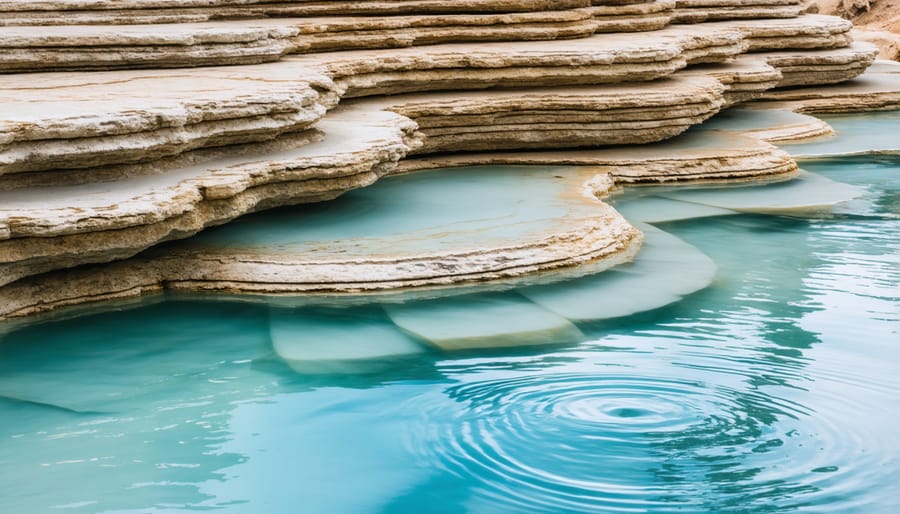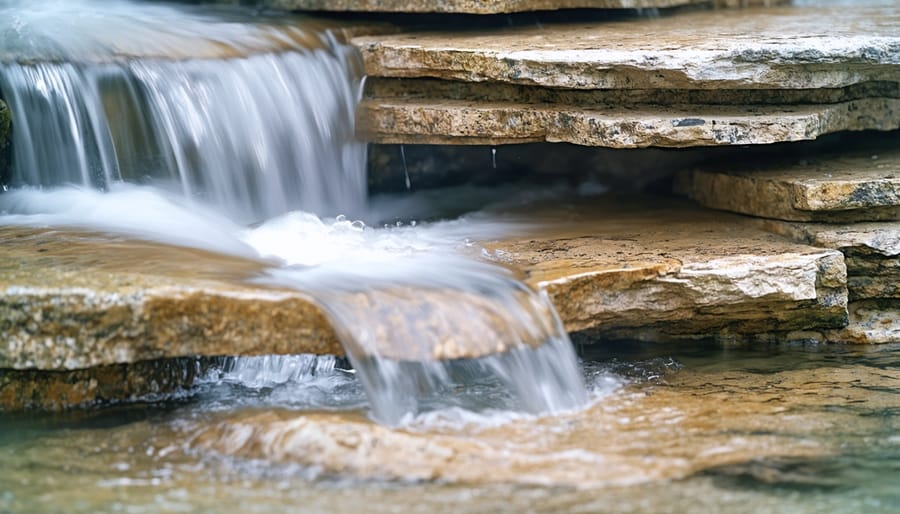Natural stone water purification systems represent one of humanity’s oldest and most effective sustainable filtration methods, combining ancient wisdom with modern engineering principles. These remarkable systems harness the natural filtering properties of materials like granite, slate, and limestone to remove contaminants while preserving essential minerals that enhance water quality.
Unlike conventional water treatment systems that rely heavily on chemicals and artificial materials, stone-based filtration offers a chemical-free alternative that can last for decades with minimal maintenance. From small-scale residential applications to large municipal systems, natural stone filtration demonstrates how nature’s own materials can effectively address our growing need for clean, safe water.
Recent studies have shown that properly designed stone filtration systems can remove up to 99% of common water contaminants while maintaining beneficial mineral content. This remarkable efficiency, combined with their minimal environmental impact and long-term durability, makes these systems an increasingly popular choice for environmentally conscious property owners and developers seeking sustainable water management solutions.
How Natural Stone Purifies Water

The Filtration Process
Natural stone filtration follows a sophisticated yet natural process that mimics Earth’s own water purification system. As water enters the system, it first encounters larger stones that trap debris and sediment. This initial stage removes visible particles and acts as a pre-filter, protecting the finer filtration layers below.
The water then flows through progressively smaller stone layers, typically starting with river rock and moving to crushed granite or quartz. Each layer serves a specific purpose in the filtration process. Medium-sized stones remove smaller particles, while finer gravels trap microscopic impurities. The angular surfaces of crushed stone provide increased surface area for beneficial bacteria to colonize, forming a biological filtration layer that breaks down organic contaminants.
At the heart of the system, specialized mineral stones like zeolite and activated carbon work through both mechanical and chemical filtration. These stones naturally attract and bind with heavy metals, chemicals, and other dissolved pollutants through a process called ion exchange. The porous structure of these stones also helps reduce unwanted odors and improve water clarity.
The final stage typically involves fine sand or crushed quartz, which performs the crucial task of removing the smallest particles and providing crystal-clear water. Throughout this journey, the water’s natural mineral content is preserved while harmful contaminants are effectively removed, resulting in clean, balanced water that maintains its beneficial properties.
Types of Stone Used in Water Purification
Several types of natural stones play crucial roles in water purification, each offering unique filtration properties. Volcanic rocks, particularly basalt and pumice, are highly effective due to their porous structure that traps sediment and harmful particles. These stones also harbor beneficial bacteria that help break down organic contaminants.
Quartz and silica-based stones are excellent for removing heavy metals and chemical impurities from water. Their crystalline structure creates a natural molecular sieve that captures unwanted substances while allowing clean water to pass through. Granite, while less porous, serves as an excellent base layer in filtration systems due to its durability and ability to support other filtering materials.
Zeolite, a naturally occurring mineral, is particularly valued for its ion-exchange capabilities, effectively removing ammonium and heavy metals from water. Its honeycomb structure provides an extensive surface area for filtration and bacterial growth that aids in purification.
Limestone and calcite stones are essential for pH adjustment, naturally neutralizing acidic water by releasing calcium and carbonate ions. These stones are often used as a final treatment stage to achieve optimal drinking water quality.
Activated carbon stones, derived from carbonaceous source materials, excel at removing chlorine, volatile organic compounds, and unpleasant tastes and odors. Their highly developed pore structure provides exceptional absorption capabilities, making them a cornerstone of many natural filtration systems.

Benefits of Stone-Based Water Purification
Environmental Impact
Natural stone water purification systems stand out as an environmentally responsible choice for water treatment. Unlike conventional systems that rely heavily on synthetic materials and chemicals, these systems harness the natural filtering properties of stones, significantly reducing their environmental footprint.
The production and sourcing of natural stones require minimal processing compared to manufactured alternatives. Most stones used in these systems are locally sourced, reducing transportation emissions and supporting regional economies. Additionally, natural stones are incredibly durable, often lasting decades without replacement, which minimizes waste and resource consumption over time.
These systems operate without electricity or chemical additives, making them energy-efficient and chemical-free. The filtered water returns to the environment free from harmful processing byproducts, maintaining the natural water cycle. When the stones eventually need replacement, they can be repurposed for landscaping or returned to nature without causing environmental harm.
The sustainable aspects extend beyond operation. Natural stone systems help preserve groundwater quality, reduce plastic waste from traditional filter cartridges, and promote water conservation through efficient filtration processes. This makes them an ideal choice for environmentally conscious homeowners and businesses committed to reducing their ecological impact.
Cost-Effectiveness
Natural stone water purification systems demonstrate remarkable cost-effectiveness over their operational lifetime. While initial installation costs may be higher than conventional filtration methods, these systems typically pay for themselves within 3-5 years through reduced maintenance requirements and operational expenses. The durable nature of natural stone means fewer replacement parts and minimal degradation, contributing to cost-effective water management solutions for both residential and commercial applications.
Annual maintenance costs average 30-40% lower than traditional systems, primarily because natural stone doesn’t require frequent chemical treatments or filter replacements. The self-sustaining biological processes within the stone matrix naturally maintain filtration efficiency, reducing the need for professional servicing. Additionally, these systems operate without electricity, eliminating associated power costs and making them particularly economical in remote locations or areas with high energy prices.
Long-term financial benefits extend beyond direct operational savings. The enhanced water quality can extend the lifespan of plumbing fixtures and appliances, while the system’s ability to work without chemical additives eliminates ongoing chemical purchase costs. Property values often increase with the installation of sustainable water management solutions, providing additional return on investment.
Water Quality Improvements
Natural stone filtration delivers remarkable water quality improvements through multiple mechanisms. As water passes through filters under marble and other stone materials, it undergoes natural mineralization, enhancing both taste and nutritional content. The stone’s microscopic pores trap sediments and impurities while allowing beneficial minerals like calcium and magnesium to dissolve into the water. This process not only removes unwanted contaminants but also creates a more balanced pH level and reduces chlorine taste and odors. The resulting water has a crisp, fresh taste that rivals premium bottled water, with the added benefit of natural mineral enrichment that synthetic filters cannot replicate.
Installation and Maintenance
System Design Options
Natural stone water purification systems can be configured in various ways to suit different spaces and requirements. For residential applications, the most common setup is a three-stage system incorporating layers of granite, quartz, and limestone. These systems can be installed either as standalone units in basements or utility rooms, or integrated into existing landscaping for a more aesthetic approach.
For outdoor installations, natural stone filtration can be designed as part of a decorative water feature, combining functionality with visual appeal. Popular configurations include cascade systems, where water flows over strategically placed stone layers, and pressure-driven systems that force water through compressed stone chambers.
Commercial applications typically require larger-scale solutions. These often utilize multiple parallel filtration units to handle higher water volumes. Business installations commonly incorporate modular designs that allow for easy maintenance and future expansion. Some configurations include:
– Vertical tower systems for spaces with limited floor area
– Horizontal bed configurations for maximum filtration surface area
– Underground chambers for discreet installation
– Hybrid systems combining natural stone with other filtration methods
The size and layout of these systems depend on factors such as daily water usage, available space, and specific filtration requirements. Custom configurations can be designed to accommodate unique architectural features or space constraints while maintaining optimal filtration efficiency.

Installation Process
Setting up a natural stone water purification system requires careful planning and precise execution. Before installing stone filtration systems, ensure you have all necessary components and appropriate permissions from local authorities.
Begin by selecting a suitable location that’s easily accessible for maintenance and has proper drainage. The installation area should be level and capable of supporting the system’s weight when filled with water and stones.
Follow these essential steps:
1. Prepare the foundation by creating a stable, level surface using crushed gravel or concrete pad
2. Install the main containment vessel according to manufacturer specifications
3. Layer the filtration materials in the correct order:
– Bottom layer: Large gravel (2-3 inches)
– Middle layer: Medium-sized stones (1-2 inches)
– Top layer: Fine granite or quartz sand
Connect the inlet pipe at the top and outlet pipe at the bottom, ensuring watertight seals. Install a pre-filter to remove large debris and a pump sized appropriately for your system’s flow rate.
Test the system by running water through it slowly, checking for leaks and proper filtration. Initially, you may need to flush the system several times until the water runs clear. Regular maintenance intervals should be established based on usage and local water conditions.
Remember to document the installation process and keep manufacturer guidelines for future reference.
Maintenance Requirements
Regular maintenance of natural stone water purification systems is essential for optimal performance and longevity. The primary maintenance task involves backwashing the system every 2-4 weeks, depending on usage and water quality. This process removes accumulated sediment and prevents clogging of the stone layers.
Monthly inspection of the stone media is recommended to check for channeling or compaction. If you notice uneven water flow or reduced filtration efficiency, gentle redistribution of the stone layers may be necessary. Every six months, test the pH levels and mineral content of both incoming and filtered water to ensure proper filtration.
Annual maintenance should include a thorough cleaning of all components and replacement of approximately 10-15% of the stone media. Most systems require complete stone replacement every 5-7 years, though this varies based on water quality and system usage.
Keep detailed maintenance records and regularly inspect for:
– Unusual odors or tastes in filtered water
– Decreased water flow
– Visible sediment in filtered water
– Changes in water pressure
– Signs of biological growth
If your system includes UV sterilization or additional filters, follow manufacturer-specific maintenance schedules for these components. During winter months in cold climates, protect the system from freezing by maintaining consistent water flow or implementing appropriate insulation measures.
For optimal performance, consider professional servicing annually, especially for complex installations or commercial applications.
Case Studies and Real-World Applications
Natural stone water purification systems have proven their effectiveness in various real-world applications across the globe. In Vermont, the Mountain Pure Water Treatment Facility implemented a multi-layer granite and limestone filtration system in 2019, successfully treating 50,000 gallons of water daily while reducing chemical treatment needs by 60%. The system’s natural mineralization process has improved water taste and reduced maintenance costs by 40% compared to conventional methods.
In Karnataka, India, a rural community project demonstrates the scalability of stone filtration systems. Using locally sourced granite, slate, and quartz arrangements, the system provides clean drinking water to over 2,000 residents. Water quality tests show a 95% reduction in bacterial contamination and significant improvements in turbidity levels, all achieved without electrical power or chemical additives.
The Echo Valley Eco-Resort in Costa Rica showcases how stone filtration can integrate with modern sustainable architecture. Their system combines volcanic rock, river stones, and crystalline quartz in a terraced design that naturally purifies rainwater for guest accommodations. This installation processes 10,000 gallons monthly while serving as an educational exhibit for visitors interested in sustainable water management.
An urban application in Portland, Oregon, demonstrates how stone filtration systems can work in residential settings. A community garden complex utilizes a cascading stone filter system that purifies collected rainwater for irrigation. The system incorporates local river rock and granite, processing 5,000 gallons monthly while creating an attractive landscape feature.
These examples highlight the versatility and effectiveness of natural stone filtration across different scales and contexts. Each case demonstrates successful integration with existing infrastructure while providing sustainable, low-maintenance water purification solutions that benefit both users and the environment.
Natural stone water purification systems represent a sustainable and effective solution for modern water treatment needs. As we’ve explored, these systems combine ancient wisdom with contemporary engineering to deliver clean, mineral-enriched water while maintaining environmental responsibility. The growing demand for eco-friendly filtration solutions suggests a promising future for stone-based systems, with ongoing research focused on optimizing mineral combinations and improving filtration efficiency. Industry trends indicate increased adoption in both residential and commercial applications, particularly as awareness of environmental impacts grows. Looking ahead, we can expect to see more innovative implementations of stone filtration technology, including smart monitoring systems and hybrid solutions that combine natural stones with other sustainable materials. As water quality concerns continue to rise globally, natural stone filtration stands poised to play an increasingly vital role in sustainable water management solutions.










